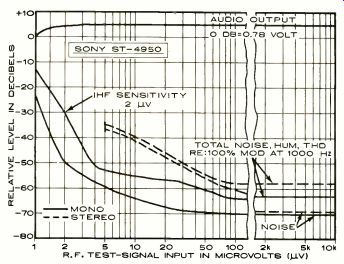
SONY has recently announced a new line of restyled and redesigned top-end audio components, among them the ST-4950 AM/FM stereo tuner. In size and appearance, it is a companion to their new TA-4650 integrated amplifier.
The MOSFET "front end" of the tuner is followed by an i.f. amplifier using two integrated-circuit stages with four sections of ceramic filtering. The multiplex demodulator is a phase-locked-loop IC, and a number of discrete components and transistors are used for auxiliary functions such as metering. The AM tuner circuit is basic and simple, with ceramic filters for i.f. selectivity.
The gold satin-finish front panel is dominated visually by two rectangular "blackout" openings. The larger contains the tuning-dial scales, which light in soft green when the tuner is on. The FM tuning calibrations are linearly distributed across the scale. A red light-emitting diode installed at the end of the traveling dial pointer not only indicates the tuned frequency, but its length doubles when a station is received.
In the smaller opening are the two tuning meters (signal strength and FM center tuning), and the word STEREO appears in red when a stereo broadcast is tuned in. To the left of this window is a push-on/push-off power switch, and at the top right of the panel is the large tuning knob and a small black MUTING switch.
The lower right portion of the panel contains three black pushbuttons for AFC, HI BLEND (which reduces noise on weak stereo signals by partially blending the higher audio frequencies), and MULTIPATH. The latter, when pressed, causes the signal -strength meter pointer to drop to near its zero reading. Any multipath distortion (which superimposes amplitude modulation on an FM signal) causes the meter to "kick" upward. A rotatable antenna used with the tuner should be adjusted for minimum meter activity, indicating minimum distortion. Finally, a small knob selects AM, FM MONO, and FM STEREO modes.
In the rear of the tuner are the antenna terminals, including one for a wire AM antenna and a separate coaxial connector for a 75 -ohm FM antenna feedline. There is a pivoted AM ferrite -rod antenna as well. Two pairs of audio outputs are provided, one at a fixed level and the other adjustable by adjacent screwdriver slot controls. A jack supplies a signal before de -emphasis for possible use with a future four-channel demodulator. The Sony ST 4950 tuner is approximately 17 inches wide, 6 1/2 inches high, and 13 inches deep: it weighs about 17 pounds in its metal cabinet.
Price: $350.
Laboratory Measurements. The measured IHF sensitivity of the Sony ST -4950 was 2 microvolts (µV), very close to its rated 1.9 µV. Much more important was the fact that the 50 -dB quieting sensitivity was also 2 µV - the first time in our experience that this has happened. The reason is simple: even at this very low signal level, the tuner's noise level is so exceptionally low that it is even be low the very low distortion level.
--------

--- The levels of both random noise and THD (which includes noise and
distortion) are compared with the audio -output level as input -signal
strength increases. Both mono and stereo are shown.
The stereo sensitivity was 5µV (the automatic stereo switching threshold), and 50 dB of stereo quieting was reached at the rather low input of 25 µV. The ultimate distortion (at 1,000 µV) was extraordinarily low, measuring 0.074 per cent in mono and 0.13 per cent in stereo. The ultimate quieting was also excellent, about 70 dB in mono and 68.5 dB in stereo.
When a tuner exhibits these outstanding characteristics, we expect it to excel in its other aspects, and we were not disappointed.
The capture ratio was 1.1 dB, and the AM rejection was a superior 70 dB. The alternate-channel selectivity was 72 dB, image rejection was 80 dB, and the I9 -kHz pilot carrier leak age was 68 dB below 100 per cent modulation. The muting threshold, like the stereo threshold, was set to 5 to 6 µV.
The frequency response of the ST -4950 was within ±1 dB from 30 to 15,000 Hz.
Stereo channel separation was between 40 and 46 dB at frequencies from 50 to 2,300 Hz, and was still a good 25 dB at 15,000 Hz. The audio output was 0.78 volt at the fixed outputs and up to 1.83 volts at the variable outputs.
In contrast to the outstandingly fine FM section of the tuner, the AM section had a severely restricted frequency response--down 6 dB at 210 and 2,200 Hz.
Comment. It is difficult to criticize the Sony ST -4950, surely one of the top-performing units we have tested, as an FM tuner.
The muting circuit in our sample occasionally admitted a bit of noise as it went into action, but otherwise the handling of the tuner was silky smooth. Needless to say, its sound was nothing more or less than what was being broadcast. The FM tuning dial, with its long scale and linear calibration, proved to be as accurate as its marking suggested, and the maximum error we found across the entire FM band was less than the width of the pointer, corresponding to about 50 kHz. Altogether, then, the Sony ST -4950 tests out to be a simply beautiful product.
Also see:
Sherwood S-7010 AM/FM Stereo Receiver